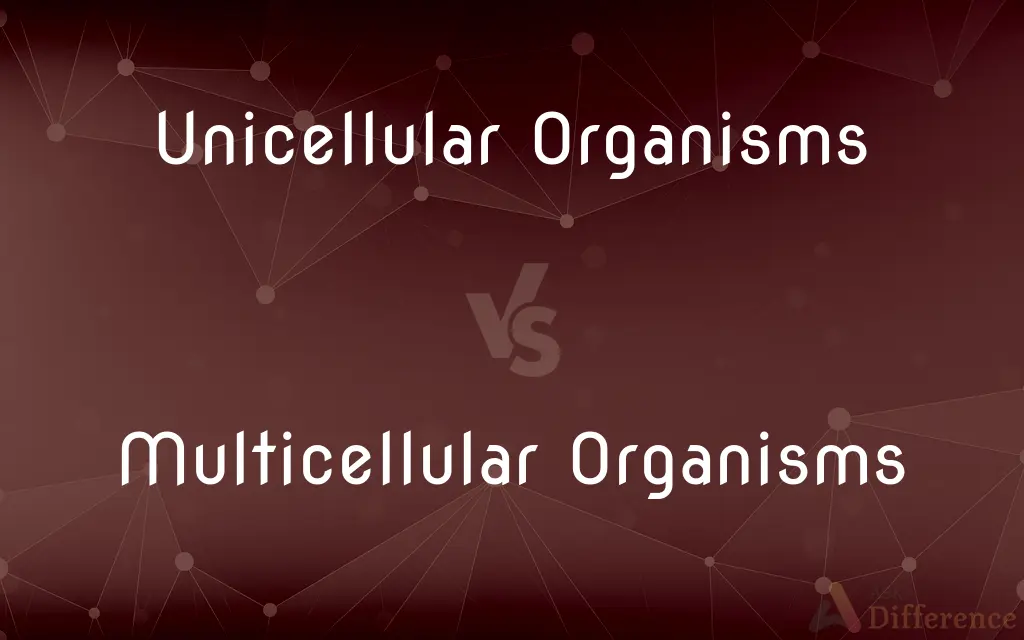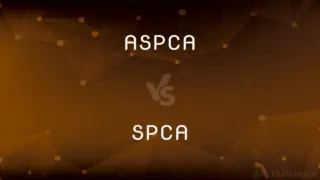Unicellular Organisms vs. Multicellular Organisms — What's the Difference?
By Tayyaba Rehman — Published on December 13, 2023
Unicellular Organisms consist of a single cell, while Multicellular Organisms are composed of multiple cells working together.

Difference Between Unicellular Organisms and Multicellular Organisms
Table of Contents
ADVERTISEMENT
Key Differences
Unicellular Organisms are life forms that exist as a single cell, encompassing all the essential functions within that one cell. This means that within one cell, functions like metabolism, reproduction, and nutrient processing occur. In contrast, Multicellular Organisms consist of numerous cells, each potentially having a specialized role. These cells work in tandem, often differentiating into various types to perform specific tasks.
Unicellular Organisms, due to their simple structure, are often microscopic and include entities like bacteria and certain algae. On the flip side, Multicellular Organisms range from small plants and fungi to large animals like humans and whales. As Multicellular Organisms grow, their complexity often increases, requiring a coordinated effort of cells, tissues, and organs.
Both Unicellular and Multicellular Organisms are critical to our understanding of life, evolution, and biological functions.
Comparison Chart
Basic Definition
Organisms made up of a single cell
Organisms comprising multiple cells
Complexity
Generally simpler
More complex with specialized cells and structures
ADVERTISEMENT
Size
Typically microscopic
Can range from microscopic to very large
Examples
Bacteria, protozoa
Plants, animals, fungi
Growth Mechanism
Increase in number through cell division
Growth through cell multiplication and differentiation
Compare with Definitions
Unicellular Organisms
Life forms performing all vital functions within one cell.
Yeast, used in baking, belongs to the category of Unicellular Organisms.
Multicellular Organisms
Entities composed of multiple cells working cooperatively.
Humans are complex Multicellular Organisms.
Unicellular Organisms
Organisms that exist as a single cell.
Amoeba is a common example of Unicellular Organisms.
Multicellular Organisms
Entities whose growth involves cell multiplication and differentiation.
Flowering plants grow and reproduce as Multicellular Organisms.
Unicellular Organisms
Entities encompassing their entire existence within a solitary cell.
Certain algae are Unicellular Organisms that perform photosynthesis.
Multicellular Organisms
Organisms in which cells are organized into tissues, organs, and systems.
Birds, with their distinct organ systems, are Multicellular Organisms.
Unicellular Organisms
Organisms with a simple structure often visible only under a microscope.
Bacteria causing infections are Unicellular Organisms.
Multicellular Organisms
Life forms with an intricate structure of numerous cells.
Insects like bees and ants are Multicellular Organisms with specific roles for different cells.
Unicellular Organisms
Single-celled entities responsible for a variety of natural processes.
Plankton, which forms the base of aquatic food chains, includes Unicellular Organisms.
Multicellular Organisms
Organisms where cells differentiate to perform specialized tasks.
Trees, with their varied cell types, are examples of Multicellular Organisms.
Common Curiosities
Do Multicellular Organisms always have organs and tissues?
Not always. While many do, some simpler Multicellular Organisms might not have differentiated organs and tissues.
How do Multicellular Organisms differ?
Multicellular Organisms are composed of multiple cells that often have specialized functions and work in coordination.
Can Unicellular Organisms be seen with the naked eye?
Typically, no. Most Unicellular Organisms are microscopic.
How do Unicellular Organisms reproduce?
Most reproduce asexually through processes like binary fission.
How do cells in Multicellular Organisms communicate?
They often use signaling molecules and have direct connections, like gap junctions, to communicate.
Can Multicellular Organisms reproduce asexually?
Yes, some can. For example, certain plants reproduce through cuttings or runners.
What are Unicellular Organisms?
Unicellular Organisms are organisms that consist of only a single cell, performing all essential life functions within that cell.
Which came first in evolution, Unicellular or Multicellular Organisms?
Unicellular Organisms are believed to have appeared first in evolutionary history.
Can Unicellular Organisms sense their environment?
Yes, many can sense and react to environmental cues, even without a nervous system.
Are viruses Unicellular Organisms?
No, viruses aren't considered living organisms and thus aren't categorized as Unicellular.
Can Multicellular Organisms revert to a single-cell stage?
Some can produce single-celled reproductive units, like spores or gametes, but the organism itself doesn't revert.
Why are Multicellular Organisms often larger?
With specialized cells for support, transport, and other functions, Multicellular Organisms can achieve larger sizes.
How do Unicellular Organisms obtain nutrients?
They often absorb nutrients directly from their environment.
Do all Multicellular Organisms have a nervous system?
No, only certain advanced Multicellular Organisms have developed nervous systems.
What's an example of a Unicellular organism in the human body?
Certain bacteria in the human gut are examples of Unicellular Organisms.
Share Your Discovery

Previous Comparison
Nucleotide vs. Nucleic Acid
Next Comparison
ASPCA vs. SPCAAuthor Spotlight
Written by
Tayyaba RehmanTayyaba Rehman is a distinguished writer, currently serving as a primary contributor to askdifference.com. As a researcher in semantics and etymology, Tayyaba's passion for the complexity of languages and their distinctions has found a perfect home on the platform. Tayyaba delves into the intricacies of language, distinguishing between commonly confused words and phrases, thereby providing clarity for readers worldwide.
















































